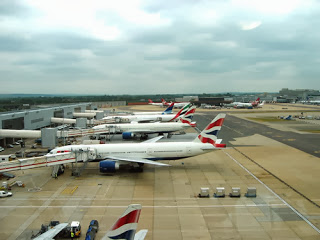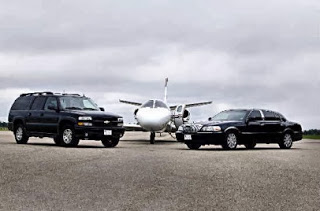Some times you as a civil engineer stuck in certain tasks where you find difficult in counting variable or parameters on which your certain given task is dependent on; Airport planning is such a daunting task; there are alot of parameters and variables which you have to consider so that your decisions might not get challenged in the future afterwards.
The location of an airport will be influenced by the following factors
1. Type of development of the surrounding area
2. Atmospheric conditions
3. Accessibility to ground transport
4. Availability of land for expansion
5. Presence of other airports in the general area
6. Surrounding obstructions
7. Economy of construction
8. Availability of utilities
9. Proximity to aeronautical demand
10. Environmental considerations
1) Type of development of the surrounding area

This is an extremely important factor, since the activity of airport, particularly from the standpoint of noise is often quite objectionable to the airport’s neighbors. Thus a study of current and prospective uses of land adjacent to an airport site is essential. Sites which offer the closest compatibility with airport activities should be given priority.
Proximity to residential areas and schools should be avoided whenever possible. An airport is essential to a community’s transport complex; yet it is an integral part of the community. Hence it is subject to the same principles and policies that govern other elements of a community plan and must be coordinated with existing as well as planned features. It is desirable to provide a buffer zone between the runways, taxiways, apron, etc; and the boundaries of the airport property, in order that nuisance created by activities of the airport be at least partially attenuated.
Noise is an extremely important factor where jet aircraft operations are anticipated. Since the introduction of jet aircraft, adverse community reaction to noise has grown rapidly. In several large urban areas, the FAA has prescribed specific flight patterns for aircraft arriving and departuring from the airport.
Regulations on a national scale have also been formulated. Aircraft and engine manufacturers are well aware of this problem, and every effort is being made to reduce noise consistent with the operating economics and safety of the aircraft.
2) Atmospheric conditions
The presence of fog, haze, and smoke reduces visibility and thereby has the effect of lowering the traffic capacity of the airport since the capacity when the visibility is poor is less that that when the visibility is good. Fog has a tendency to settle in to areas where there is little wind. Lack of wind can be caused by surrounding topography. Likewise, smoke and haze are present in the vicinity of large industrial areas.
3) Accessibility to Ground Transport
Transport time from the passenger’s point of origin to the airport is a matter of major concern. In many cases the ground time exceeds the air time by a considerable margin. With the introduction of jet transport the margin has increased even more. For a journey of 400 miles between two large metropolitan areas, ground times are as much as double the air time.
Surveys that have been made of ground transport to the airport indicate that in the united state the majority of passengers, visitors and airport and airline employees travel by private automobiles. Indications are that this trend will continue in the future. Origin and destinations of travelers to and from the airport are widely important.
4) Availability of Land fro Expansion
In a field so dynamic aviation, it is necessary to acquire in advance or be able to acquire sufficient real estae in the future for expanding the airport plant. Historically as the size of aircraft and the volume of traffic increased, runways have had to be lengthened, terminal facilities expanded and additional support facilities provided. Sufficient real estate must be available to accommodate new facilities.
5) Presence Of Other Airport In The General Area
Presence of other airports in the general area must be given consideration when a site for new airport is being selected or when additional runways are provided at an existing airport. Airports should be located at a sufficient distance from each other to prevent aircraft which are maneuvering for a landing at one airport from interfering with movements of aircraft at other airport. The minimum distance between airports depends entirely on the volume and the type of traffic and whether the airports are equipped to operate under poor visibility conditions (IFR).
6) Surrounding Obstructions
Site for airports should be so selected that approaches necessary for the ultimate development of the site are free of obstructions or can be cleared if obstructions exist. The provisions and protection of adequate approach to an airport will necessitate height restrictions in the airport turning zones and in line with the runways. Steps should be taken in the planning stage to preclude the possibility of future erection of obstructions to aircraft using the airport. The purchase of real estate necessary to protect approached obviously is not economically feasible; hence zoning for height restrictions should be initiated as soon as a site has been selected.
7) Economy of Construction
It goes without saying that if alternative site are available and they are equally adequate, the site which is more economical to construct should be given consideration. Sites lying on submerged lands are much more costly to develop than those on dry land. Rolling terrain require much more grading than flat terrains.
8) Availability of Utilities
An airport, particularly a large one requires large quantity of water, natural gas or oils, electric powers and fuel for aircraft and surface vehicles. In selections of an airport site, the provision for these utilities must be given considerations. Most of these utilities will have to be transported to the airport by truck, rail, sea, or pipeline. Another factor which must be considered is the disposal of sewage. On a new site which is not near available sewers a disposal plant may have to be constructed. In the case of electric power, most large airports must provide generating plants of their own to be emergency in the event a commercial source fails.
9) Proximity to Aeronautical Demand
In the selection of a new airport’s site, it is quite important that the location be such as to result in the shortest ground access time possible. The airline traveler is more interested in his overall door-to-door time than just the portion in the airs. The capability of airport to accommodate demand, distribution of demand and airspace limitations indicates a runway aeronautical efficiency.
10) Environmental Consideration
It involves;
• Significant noise impact of aircraft over-flights of residential areas.
• Longer distance vehicular engine exhausts
• Dwelling requiring relocation
• Acres removed from grazing
Keywords for Airport Lightning
- airport planning and design
airport planning and design ppt
airport planning ppt
airport planning manual part 1
airport planning and design book download
airport planning and design pdf
airport planning and design by khanna
airport planning and design by khanna pdf


















